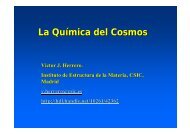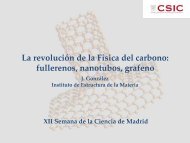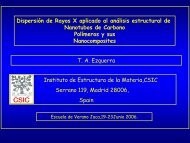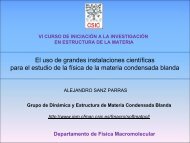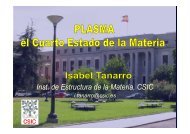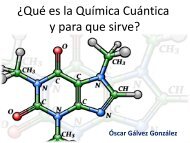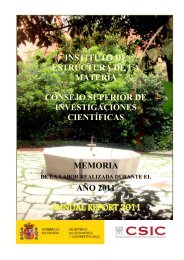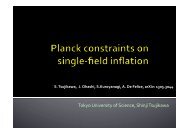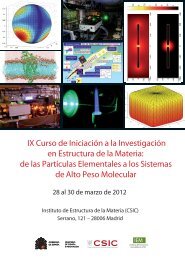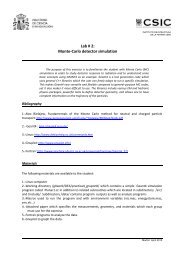GAS PHASE CHEMISTRY IN THE TROPOSPHERE (2) July, 3 2009 ...
GAS PHASE CHEMISTRY IN THE TROPOSPHERE (2) July, 3 2009 ...
GAS PHASE CHEMISTRY IN THE TROPOSPHERE (2) July, 3 2009 ...
You also want an ePaper? Increase the reach of your titles
YUMPU automatically turns print PDFs into web optimized ePapers that Google loves.
<strong>2009</strong> Jaca Summer SchoolSPECTROSCOPY OF <strong>THE</strong> ATMOSPHERESSPECAT 09<strong>GAS</strong> <strong>PHASE</strong> <strong>CHEMISTRY</strong> <strong>IN</strong> <strong>THE</strong><strong>TROPOSPHERE</strong> (2)Enrique VerdascoDpto. Química Física IUCM<strong>July</strong>, 3 <strong>2009</strong><strong>2009</strong> Jaca Summer SchoolSPECTROSCOPY OF <strong>THE</strong> ATMOSPHERESSPECAT 09OUTL<strong>IN</strong>E• Introduction• Oxidation and transformation– Photochemical chain initiation– Oxidations steps– Tropospheric ozone production– The importance of NO x– The nitrate radical– Compounds of sulphur• Air pollution– Clean and polluted air– Primary and secondary pollutants– Sulphur dioxide chemistry– Photochemical smog<strong>July</strong>, 3 <strong>2009</strong> Enrique Verdasco Gas phase chemistry in the troposphere (2) 1
<strong>2009</strong> Jaca Summer SchoolSPECTROSCOPY OF <strong>THE</strong> ATMOSPHERESSPECAT 09Introduction• The troposphere is a large reactor with hundreds of trace species• Hydroxyl radical– Dominates the daytime chemistry of the troposphere as the oxygen andozone dominate the stratospheric chemistry– The high reactivity makes this radical capable to oxidize any tracecompound with long enough physical or chemical lifetime• Hydrocarbons and CO yield CO 2 and water• Low temperature combustion• NO x and SO 2 participate in the combustion processes– Species with very long lifetime such us CH 4or N 2O or CFC’s are able toreach the stratosphere– Hydroxyl radicals chemistry in troposphere is the molecule that cleansatmosphere (troposphere) DETERGENT!• NO 3– Substitutes OH radical at night as the dominant oxidant specie in thetroposphere<strong>July</strong>, 3 <strong>2009</strong> Enrique Verdasco Gas phase chemistry in the troposphere (2) 2• Gases source<strong>2009</strong> Jaca Summer SchoolSPECTROSCOPY OF <strong>THE</strong> ATMOSPHERESSPECAT 09Introduction– Earth surface is the main source of trace gases• Natural sources: Evenly distributed (almost)• Anthropogenic sources: concentrated in urban and industrial areas.Mainly in the northern hemisphere– Minor contribution• Thunderstorms: NO xy CO• Volcanoes: Sulphur compuonds– Photochemical reactions• Radical-chain chain reactions are driven photochemically• Stratosphere limits to wavelengths longer than 280 nm• The most important labile species are O 3, NO 2and formaldehyde• This three species can lead to OH and HO 2(O 3is most important)• Origin of the tropospheric ozone<strong>July</strong>, 3 <strong>2009</strong> Enrique Verdasco Gas phase chemistry in the troposphere (2) 3
<strong>2009</strong> Jaca Summer SchoolSPECTROSCOPY OF <strong>THE</strong> ATMOSPHERESSPECAT 09Oxidation and transformation• Photochemical chain initiationPhotochemical chain initiation– The ozone photolysis in absence of CH 4 at approx. 310 nmO 3+ hv → O * ( 1 D 2 ) + O 2* ( 1 ∆ g ) (1)• The fate of O ( 1 D 2 ) , a metastable state, will be thequenching or react with water• H 2 O mixing ratios of 1 % in the troposphere (typical)O * ( 1 D 2 ) + H 2 O → OH + OH (2)O * ( 1 D 2 ) + M → O ( 3 P 2 ) + M (M = N 2 , O 2 ) (3)<strong>July</strong>, 3 <strong>2009</strong> Enrique Verdasco Gas phase chemistry in the troposphere (2) 4<strong>2009</strong> Jaca Summer SchoolSPECTROSCOPY OF <strong>THE</strong> ATMOSPHERESSPECAT 09Oxidation and transformationPhotochemical chain initiation• However virtually all O atoms will regenerate ozone– Same reaction as in the stratosphereO * ( 3 P 2 ) + O 2 + M → O 3 + M (4)• Reaction rate for production of OH– Depends on rates of processes (2) and (3) (K 3 ≈ 10·k 2 )• 10 % of O ( 1 D 2) generated in (1) will produce OH– Depends on quantum yield of process (1). Wavelength dependent– What does happen if there is not O 3 ?– Photolysis at λ ≤ 400 nm of NO 2NO 2 + hv → O + NO (5)• Followed by recombination (4) can provide ozone– NO can be oxidized back to NO 2 , so ozone production is not limitedto stoicheiometrically by NO 2 molecules initially present<strong>July</strong>, 3 <strong>2009</strong> Enrique Verdasco Gas phase chemistry in the troposphere (2) 5
<strong>2009</strong> Jaca Summer SchoolSPECTROSCOPY OF <strong>THE</strong> ATMOSPHERESSPECAT 09Oxidation and transformationOxidations steps• Reaction of OH with CO and methane in unpollutedatmosphere– Roughly 70 % of OH reacts with CO– Roughly 30 % of OH reacts with CH 4OH + CO → H + CO 2 (6)OH + CH 4 → CH 3 + H 2 O (7)• The two new (active) species are radicals– They react with oxygen producing peroxy radicals: The bondstrength in these radicals are more labile than in the O 2 moleculeH + O 2 + M → HO 2 + M (8)CH 3 + O 2 + M → CH 3 O 2 + M (9)<strong>July</strong>, 3 <strong>2009</strong> Enrique Verdasco Gas phase chemistry in the troposphere (2) 6<strong>2009</strong> Jaca Summer SchoolSPECTROSCOPY OF <strong>THE</strong> ATMOSPHERESSPECAT 09Oxidation and transformationOxidations steps• Tropospheric regions where [NO] is very low– Termination processes are• Recombination of two peroxy radical, or one peroxy and one methyl l peroxyfinishing the propagation– Both reaction products are water soluble• Physical wet deposition– Cloud dropletsHO 2 + HO 2 → H 2 O 2 (10)HO 2 + CH 3 O 2 → CH 3 OOH + O 2 (11)• Products of reactions (10) and (11) can be photolysed– Yielding OH radicals<strong>July</strong>, 3 <strong>2009</strong> Enrique Verdasco Gas phase chemistry in the troposphere (2) 7
<strong>2009</strong> Jaca Summer SchoolSPECTROSCOPY OF <strong>THE</strong> ATMOSPHERESSPECAT 09Oxidation and transformationOxidations steps• Tropospheric regions where [NO] is not very low– Reaction processes with NO analogous to the stratosphere oneHO 2 + NO → OH + NO 2 (12)CH 3 O 2 + NO → CH 3 O + NO 2 (13)• The methoxy radical– It reacts with O 2and produces formaldehyde• Formaldehyde is photochemically labile ( λ ≤ 338 nm) and theradicals produced reenter in the HO x chainCH 3 O + O 2 → HCHO + HO 2 (14)HCHO + hv → H + HCO (15)<strong>July</strong>, 3 <strong>2009</strong> Enrique Verdasco Gas phase chemistry in the troposphere (2) 8<strong>2009</strong> Jaca Summer SchoolSPECTROSCOPY OF <strong>THE</strong> ATMOSPHERESSPECAT 09Oxidation and transformationOxidations steps• H and HCO radicals produced in reaction (15) reenter in the HO x chain– H does as in reaction (8)– HCO reacts with oxygen regenerating HO 2HCO + O 2 → CO + HO 2 (16)• Conversion of NO and NO 2 preserving active radicals– More combustion of CO and CH 4– Conversion of NO to NO 2Cyclic process essential totropospheric ozone production !!<strong>July</strong>, 3 <strong>2009</strong> Enrique Verdasco Gas phase chemistry in the troposphere (2) 9
<strong>2009</strong> Jaca Summer SchoolSPECTROSCOPY OF <strong>THE</strong> ATMOSPHERESSPECAT 09Oxidation and transformationOxidations steps• The aldehydes and ketones R’CHO and R’R’’CO can bephotolysed as formaldehyde or further oxidized by OH radical• For the acetaldehydeCH 3 CHO + OH → CH 3 CO + H 2 O (21)CH 3 CO + O 2 → CH 3 CO.O 2 (22)• Producing the acetylperoxy radical– This radical adds NO 2to produce peroxyacetyl nitrate, PANCH 3 CO.O 2 + NO → CH 3 CO.O + NO 2 (23)CH 3 CO.O → CH 3 + CO 2 (24)<strong>July</strong>, 3 <strong>2009</strong> Enrique Verdasco Gas phase chemistry in the troposphere (2) 12<strong>2009</strong> Jaca Summer SchoolSPECTROSCOPY OF <strong>THE</strong> ATMOSPHERESSPECAT 09Oxidation and transformationTropospheric ozone production• Tropospheric ozone production is the key for combustion of hydrocarbons– Photolysis of NO 2– Conversion of peroxy- to oxy- radicals (HO 2and RO 2)NetO ( 3 P 2 ) + O 2 + M → O 3 + M (4)NO 2 + hv → O + NO (5)OH + CO → H + CO 2 (6)H + O 2 + M → HO 2 + M (8)HO 2 + NO → OH + NO 2 (12)CO + 2O 2 + hν → CO 2 + O 3<strong>July</strong>, 3 <strong>2009</strong> Enrique Verdasco Gas phase chemistry in the troposphere (2) 13
<strong>2009</strong> Jaca Summer SchoolSPECTROSCOPY OF <strong>THE</strong> ATMOSPHERESSPECAT 09Oxidation and transformationTropospheric ozone production• What happened below a critical ratio [NO]/[O 3 ]?– Ozone loss startsHO 2 + O 3 → OH + 2O 2 (25)CO + OH → H + CO 2 (6)H + O 2 + M → HO 2 + M (8)Net CO + O 3 → CO 2 + O 2• Models predict that production of O 3 exceeds looses if NO mixing ratiosare grater than 3·10 -11– Remote regions (Pacific) with very low [NO] are sinks of O 3– Urban regions below boundary layer with high [NO] are sources of O 3• As long NO x is available and CO or CH 4 are supplied, tropospheric ozone productionis guaranteed.• Each CO molecule can generate one O 3 molecule• Each CH 4 molecule can supply as many as 3.5 molecules<strong>July</strong>, 3 <strong>2009</strong> Enrique Verdasco Gas phase chemistry in the troposphere (2) 14<strong>2009</strong> Jaca Summer SchoolSPECTROSCOPY OF <strong>THE</strong> ATMOSPHERESSPECAT 09Oxidation and transformationTropospheric ozone production• Tropospheric loss processes– Visible photolysis– Reactions with NO 2and HO 2– Reactions with unsaturated hydrocarbons• Models predict a roughly in situ balance between sources and sinks– Result consistent with estimates of surface sink and stratosphericinjection rate–• Troposphere abundance of ozone is crucial for atmosphere– It is the primary source of OH radical– It is also a oxidizing agent by itself<strong>July</strong>, 3 <strong>2009</strong> Enrique Verdasco Gas phase chemistry in the troposphere (2) 15
<strong>2009</strong> Jaca Summer SchoolSPECTROSCOPY OF <strong>THE</strong> ATMOSPHERESSPECAT 09Oxidation and transformationThe importance of NO X• The NO X species, specially NO, radical areNO 2very important in the tropospheric ozoneOHCHdistribution and oxidation rates4– Models predict that tropospheric ozoneNOHO 2production depends critically on altitude-CH 3 Oconcentration profiles of NO 2x– Natural sources (50 %)NO CH 3O• Microbiological producing NO and N 2 OO 2• Oxidation of NH 3 by OH• Lightning (10 %)NO 2– Anthropogenic (50 %)HO 2• Biomass burningWithout NO xWith NOCH x3OOH• High temperature combustionO 3CH 3O 2<strong>July</strong>, 3 <strong>2009</strong> Enrique Verdasco Gas phase chemistry in the troposphere (2) 16<strong>2009</strong> Jaca Summer SchoolSPECTROSCOPY OF <strong>THE</strong> ATMOSPHERESSPECAT 09Oxidation and transformationThe importance of NO X• Species NO and NO 2 (NOx ) are implicated in tropospheric ozone productionNO 2 + hv → O + NO (5)O + O 2 + M → O 3 +M (4)O 3 + NO → NO 2 + O 2 (26)dNO [2]dt[ O]dO [ ]=− j [ NO ] + k [ O][ O ][ M] ≈0dt1/2⎧ 2jNO [ ]1=⎪⎡⎛j ⎞ 4 j ⎤ j[ O3] ss= ⎨⎢[ NO2]0k26[ NO]⎜ ⎟ + ⎥ −2 ⎪⎢⎝k ⎠ k ⎥ k⎩⎣⎦=− j5[ NO2] + k26[ O3][ NO]5 2 4 2j [ NO ]= 5 2ss[ O23]ssk4[ O2][ M]5 5 526 26 26• Maximum [O 3 ] reached when [NO] 0 = 0 and there is only [NO 2 ].– [O 3] = 0 if [NO 2] 0= 0; Never is [NO] 0= 0⎫⎪⎬⎭⎪<strong>July</strong>, 3 <strong>2009</strong> Enrique Verdasco Gas phase chemistry in the troposphere (2) 17
<strong>2009</strong> Jaca Summer SchoolSPECTROSCOPY OF <strong>THE</strong> ATMOSPHERESSPECAT 09Oxidation and transformationThe importance of NO X• All mentioned sources, except lightning, release NO X species intoboundary layer– In this layer most of NO xis oxidized by OH radicals to HNO 3andphysically removed by wet deposition– Very low values of [NO] in remote regions seems to indicate injection ofNO xfrom stratosphere, as a mayor source of NO xin the uppertroposphere– Recently measured values of [NO[x] much larger– Transport of NO xcould be important• Chemical lifetime of NO x is around 24 hours and spatial scale of about 1km• Reservoir compounds: adduct peroxyacetyl nitrate (PAN)– PAN was discover in urban zones as an air pollutant (smog)– Recently was also observed in rural areas• Pacific ocean [PAN] ≈ 10-400ppt (free NO 2only 30 ppt)– PAN formation is an exothermic equilibrium: shifted to the right t at low temperatures• Above boundary layer PAN can travel very long distances<strong>July</strong>, 3 <strong>2009</strong> Enrique Verdasco Gas phase chemistry in the troposphere (2) 18<strong>2009</strong> Jaca Summer SchoolSPECTROSCOPY OF <strong>THE</strong> ATMOSPHERESSPECAT 09Oxidation and transformationThe nitrate (NO 3 ) radical• The NO 3radical is known since 1881 by spectrophotometric measurements• Plays a very important role in both stratospheric and tropospheric chemistryNO 2 + O 3 → NO 3 + O 2 (27)N 2 O 5 + M ⇔ NO 3 + NO 2 + M (28)• N 2O 5molecule is by itself an important product.– Reacts heterogeneously with water yielding HNO 3• Physically removed by wet deposition• NO 3does not react in water, but does react with aqueous negative ionsi• Physically removed by wet deposition• NO 3is rapid photolysed during light hours– Yield is wavelength dependentNO 3 + hν (λ < 700 nm) → NO + O 2 (29)NO 3 + hν (λ < 580 nm) → NO 2 + O (30)<strong>July</strong>, 3 <strong>2009</strong> Enrique Verdasco Gas phase chemistry in the troposphere (2) 19
<strong>2009</strong> Jaca Summer SchoolSPECTROSCOPY OF <strong>THE</strong> ATMOSPHERESSPECAT 09Oxidation and transformationThe nitrate (NO 3 ) radical• In the troposphere NO 3 radical reacts, at night, with most of theorganic compounds• The rate constants of OH with hydrocarbons are around 30 timeslarger than raction with NO 3• In contrast, night NO 3 concentrations in troposphere are 10 3 times theday concentrations of OH (10 9 cm - 3 /10 6 cm - 3 )– CH 3-S-CH3and natural terpenes react faster with NO 3in comparison withOH• The reactions of hydrocarbons with NO 3 follow a similar path that withOH regenerating radicals HO 2 and RO 2 and providing a source of OHradical at night<strong>July</strong>, 3 <strong>2009</strong> Enrique Verdasco Gas phase chemistry in the troposphere (2) 20<strong>2009</strong> Jaca Summer SchoolSPECTROSCOPY OF <strong>THE</strong> ATMOSPHERESSPECAT 09Oxidation and transformationCompounds of sulphur• Most of natural (biogenic) sulphur compounds are emitted in reducedform H 2 S, CS 2 , OCS, CH 3 SH, CH 3 SCH 3 , CH 3 SSCH 3• All these species yield SO 2 as final oxidation process– Further homogeneous or heterogeneous oxidation produces H 2SO 4• Acid rain• Lifetimes are small, except OCS with, probably, more than 50 years– OCS is uniformly distributed in troposphere (500 ppb)– OCS can reach stratosphere• DMS is the dominant natural sulphur compound emitted from oceans– Spatial variability in the boundary layer• Its concentration decreases close to land due to continental oxidants agents<strong>July</strong>, 3 <strong>2009</strong> Enrique Verdasco Gas phase chemistry in the troposphere (2) 21
<strong>2009</strong> Jaca Summer SchoolSPECTROSCOPY OF <strong>THE</strong> ATMOSPHERESSPECAT 09Oxidation and transformationCompounds of sulphurOH + CS 2 → OCS + SH (31)OH + OCS → CO 2 + SH (32)OH + H 2 S → H 2 O + SH (33)O 2SO 2SOSH + O 2 → SO + OH (34)SH + OH → S + H 2 O (35)S + O 2 → SO + O (36)SO + O 2 → SO 2 + O (37)O 2 HSOO 3S HO 2OHOHSHHO 2, etc.H 2S OCSOHCS 2<strong>July</strong>, 3 <strong>2009</strong> Enrique Verdasco Gas phase chemistry in the troposphere (2) 22<strong>2009</strong> Jaca Summer SchoolSPECTROSCOPY OF <strong>THE</strong> ATMOSPHERESSPECAT 09Air pollutionClean an polluted air• Air is never clean; i.e. containing only N 2 , O 2 , CO 2 , H 2 Oand noble gasses.• Natural pollutants– Dust, pollen, terpenes from plants , CH 4 from animals, lightening,forest fires, volcanic eruptions, etc.• Anthropogenic– Agriculture, combustions of fuels, heavy industry– Combustion produces CO 2 , SO 2 , NO x , CO, etc.<strong>July</strong>, 3 <strong>2009</strong> Enrique Verdasco Gas phase chemistry in the troposphere (2) 23
<strong>2009</strong> Jaca Summer SchoolSPECTROSCOPY OF <strong>THE</strong> ATMOSPHERESSPECAT 09Air pollutionClean an polluted air• Pollutants released to the boundary layer– Could be degraded very fast (CO, DMS, etc)• Removed by physical deposition (minutes, hours)– Only contribute to local, or urban, contamination– Could be very stable (N 2 O, CO 2 , OCS, etc)• They are transport to free troposphere, or even to stratosphere– Increasing the total atmospheric pollution– Greenhouse effect– Global warming (warning)• An average adult:– Eats 1.2 kg of food– Drinks 2 kg of water– Breaths 13.5 kg of (polluted) air<strong>July</strong>, 3 <strong>2009</strong> Enrique Verdasco Gas phase chemistry in the troposphere (2) 24• Pollutants classification<strong>2009</strong> Jaca Summer SchoolSPECTROSCOPY OF <strong>THE</strong> ATMOSPHERESSPECAT 09Air pollutionPrimary and secondary pollutants– Primary• Emitted from a identifiable source– Secondary• Chemical transformation• More harmful effects than primary (SO 2)• Anthropogenic / Natural ratio– Total amount of pollutans are around 10-100 100 Pg·yr -1– 5-25 % pollutants are man made– Except SO 2 , where is 10-20 times larger• More than half of total sulphur compounds are emitted in the NH<strong>July</strong>, 3 <strong>2009</strong> Enrique Verdasco Gas phase chemistry in the troposphere (2) 25
<strong>2009</strong> Jaca Summer SchoolSPECTROSCOPY OF <strong>THE</strong> ATMOSPHERESSPECAT 09Air pollutionSulphur dioxide chemistry• SO 2 is a very important pollutant– It is produced in combustion of coal combustion– Mixing ratios very variable• Less than 1ppb in free troposphere• 30 ppb in rural areas in the NH• 2000 ppb (2 ppm) ) in very polluted areas• Lifetime of several weeks– Most converted to H 2 SO 4– Mechanism is very complicated,• Starts with OH addition to SO 2.• Several steps homogeneous (and probably heterogeneous)– HO 2 is produced and reaction with NO regenerates OH (catalytic)<strong>July</strong>, 3 <strong>2009</strong> Enrique Verdasco Gas phase chemistry in the troposphere (2) 26• Combustion of coal<strong>2009</strong> Jaca Summer SchoolSPECTROSCOPY OF <strong>THE</strong> ATMOSPHERESSPECAT 09Air pollutionSulphur dioxide chemistry– England coal produce also tars a higher hydrocarbons– The combustion of this coal produces a lot of particles andnucleation centers (pea-souper fogs)• In 1306 king Edward I banned use of coal• In 1905 appears the word smog (smoke + fog)– Now is known as London smog to differentiate the Los Angeles smog g orphotochemical smog• In 1952 more than 4000 people died• Afterwards severe controls on combustions were taken<strong>July</strong>, 3 <strong>2009</strong> Enrique Verdasco Gas phase chemistry in the troposphere (2) 27
<strong>2009</strong> Jaca Summer SchoolSPECTROSCOPY OF <strong>THE</strong> ATMOSPHERESSPECAT 09Air pollutionPhotochemical smog• Photochemical smog was first observed in L.A. (mid 40’s)– The symptoms are different of the London smog• Eye irritation plant damage, visibility reduction, etc.– Ozone, NO 2 , PAN, etc. produce photochemically by sunlight onmixtures of NO x and hydrocarbons• Why is produced– Geographical situation: LA is surrounding by mountains– It is facing west to the pacific ocean– Temperature inversion are very usual• Pollutants are trapped– First time observed• 1542 in San Pedro Bay (Bay of the smokes)• 1868 In Los Angeles<strong>July</strong>, 3 <strong>2009</strong> Enrique Verdasco Gas phase chemistry in the troposphere (2) 28<strong>2009</strong> Jaca Summer SchoolSPECTROSCOPY OF <strong>THE</strong> ATMOSPHERESSPECAT 09Photochemical smog• How is producedAir pollution– [NO] concentration grows at earlymorning (Pollutants emitted duringthe day after and heavy commutingtraffic)– After dawn NO is replaced by NO 2and O 3 is generated.– By noon high concentrations ofozone, PAN and other oxidantsspecies are present, resulting thetypical brown haze<strong>July</strong>, 3 <strong>2009</strong> Enrique Verdasco Gas phase chemistry in the troposphere (2) 29
<strong>2009</strong> Jaca Summer SchoolSPECTROSCOPY OF <strong>THE</strong> ATMOSPHERESSPECAT 09Air pollutionPhotochemical smog• Variation of concentration of oxidants in Southern California<strong>July</strong>, 3 <strong>2009</strong> Enrique Verdasco Gas phase chemistry in the troposphere (2) 30<strong>2009</strong> Jaca Summer SchoolSPECTROSCOPY OF <strong>THE</strong> ATMOSPHERESSPECAT 09Air pollutionPhotochemical smog• Variation of concentration of oxidantsin a propane NO and NO 2 mixture<strong>July</strong>, 3 <strong>2009</strong> Enrique Verdasco Gas phase chemistry in the troposphere (2) 31
• Thanks to:<strong>2009</strong> Jaca Summer SchoolSPECTROSCOPY OF <strong>THE</strong> ATMOSPHERESSPECAT 09Acknowledgements– Organizing committee– Rest of professors– Students<strong>July</strong>, 3 <strong>2009</strong> Enrique Verdasco Gas phase chemistry in the troposphere (2) 32<strong>2009</strong> Jaca Summer SchoolSPECTROSCOPY OF <strong>THE</strong> ATMOSPHERESSPECAT 09Final conclusion<strong>July</strong>, 3 <strong>2009</strong> Enrique Verdasco Gas phase chemistry in the troposphere (2) 33




